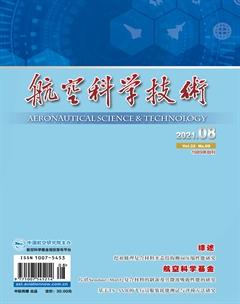弹性地基上多孔功能梯度复合材料纳米圆柱壳的自由振动研究
张飞 白春玉
摘要:为了体现弹性地基对功能梯度材料(functionally graded materials, FGMs)纳米圆柱壳力学特性的影响并考虑到FGMs结构中可能存在的孔隙,基于Mindlin应变梯度理论,建立了弹性地基上包含尺寸效应的多孔FGMs一阶剪切变形纳米壳的力学模型,这种非经典的连续介质力学纳米壳模型利用材料长度尺度参数捕捉尺寸效应。通过Hamilton变分原理得到了系统的运动微分方程,采用Navier法获得了FGMs纳米壳固有频率的解析解,研究了Winkler弹性地基上多孔FGMs纳米壳的自由振动特性。结果表明,FGMs纳米壳孔隙率的增加会导致固有频率显著降低;Winkler弹性地基增加了FGMs纳米壳的有效刚度,且纳米壳的固有频率随着Winkler弹性常数的增加而增加;随着无量纲材料长度尺度参数的增加,基于非经典连续介质力学模型得到的纳米壳固有频率逐渐收敛于基于经典模型得到的结果。提出的建模方法可以为纳米圆柱壳的相关科学研究提供借鉴和参考;研究结果可以为相关工程设计提供依据。
关键词:应变梯度理论;功能梯度复合材料;弹性地基;自由振动;孔隙率
中图分类号:V214.4文献标识码:ADOI:10.19452/j.issn1007-5453.2021.08.008
为了满足航空航天结构高强度、高韧性以及轻质等方面的要求[1-3],日本科学家在20世纪80年代中期提出功能梯度复合材料(functionally graded materials, FGMs)的概念[4]。FGMs的材料属性在空间场中连续变化,不存在内部界面,避免了传统复合材料层间的应力集中和热应力问题。该材料具有较强的抗热冲击性能、较高的机械强度和耐高温性能等优点。基于这些优越的性能,FGMs在航空航天、国防、核工业、生物医学和电子行业中的应用越来越多。尽管FGMs的应用已经取得了实质性的技术进步,但仍有一些待解决的关键问题,如FGMs结构在测试和设计方面可以参考的数据库较少[5]。所以,对于FGMs的研究能够为FGMs结构的设计和应用提供參考与借鉴,从而在FGMs结构的制备过程中有针对性地改变各组分材料体积含量的空间分布,从而达到优化结构内部应力分布的目的。
在过去的几年中,FGMs在如原子力显微镜[6-7]、微/纳米机电系统[8-9]等微/纳尺寸结构中得到了广泛的应用。微/纳米圆柱壳是各种微/纳米机电系统的重要组件[10-11],所以研究微/纳米圆柱壳的力学特性能够促使其在相关工程领域发挥其独特的优势。由于试验技术的限制和不完善,目前对微/纳米圆柱壳力学特性的试验研究极其困难。作为替代,现阶段通常采用原子法、原子/连续介质力学混合法和连续介质力学法[12]对微/纳米结构的力学特性进行研究。研究发现前两种方法都有各自的缺点和局限性[13-14],所以合适的连续介质力学理论在微/纳圆柱壳力学特性的研究中扮演着非常重要的角色。由于经典的连续介质力学理论(classical theory, CT)无法捕捉微/纳结构中的尺寸效应[15-16],所以相关学者提出了包含材料长度尺度参数的非经典连续介质力学理论,如应变梯度理论(strain gradient theory, SGT)、修正的应变梯度理论(modified strain gradient theory, MSGT)和修正的偶应力理论(modified couple stress theory, MCST)。
基于非经典连续介质力学理论,相关学者已经对FGMs微/纳圆柱壳新颖的力学特性进行了研究[17-23]。需要指出的是,在以上的研究中,尚未涉及弹性地基和孔隙对FGMs微/纳圆柱壳力学特性的影响。鉴于FGMs在制备过程中因工艺等原因其内部不可避免会产生孔隙,并且考虑到壳型结构在某些特定应用中与弹性基础接触,本文基于Mindlin SGT,考虑FGMs结构内部的孔隙效应,对Winkler弹性地基上多孔FGMs一阶剪切变形纳米圆柱壳的自由振动进行了研究。利用Hamilton变分原理得到了系统的运动微分方程,采用Navier法求得了两端简支FGMs纳米圆柱壳的固有频率。讨论了材料幂律指数、孔隙率、量纲一(旧称无量纲)长度尺度参数、Winkler弹性常数以及几何尺寸对FGMs纳米壳自由振动特性的影响。
1多孔FGMs纳米圆柱壳
如图1所示,Winkler弹性地基上的FGMs纳米圆柱壳由陶瓷和镍构成。假设FGMs纳米圆柱壳的外表面是纯陶瓷,内表面是纯镍,并且沿厚度方向含有均匀和非均匀分布的孔隙。另外,纳米壳的中面半径、厚度和长度分别为R、h和L。多孔FGMs圆柱纳米壳的材料属性如下[24-25]。
4理论模型验证
为了验证本文理论模型的正确性,将通过本文得到结果与已发表的文献结果进行了对比验证。从表1的对比结果可以看出,本文所得结果与参考文献中的结果取得了较好的一致性,充分证明了本文理论模型和公式推导的正确性,同时也保证了本文研究结果的有效性和正确性。
5数值计算及分析
基于三种理论模型,图3给出了周向波数n对多孔FGMs纳米壳固有频率的影响。从图中可以看出,随着周向波数的增加,纳米壳的固有频率先减小后增大。当m = 1时,基于三种理论模型得到的纳米壳的基频都发生在(m,n)=(1, 2)处。所以选取(m,n)=(1, 2)作为本文研究的代表模态。
图4给出了长径比L/R和量纲一长度尺度参数h/l对EDP FGMs纳米壳固有频率的影响。可以看出,量纲一固有频率随着h/l的减小而增大,因为纳米壳长度尺度参数的增大导致其内部有效刚度增大;还可以看出,随着壳体长径比的增加,纳米壳的固有频率逐渐减小,殼体L/R的增加导致其内部有效刚度减小。
图5给出了不同理论模型下多孔FGMs纳米壳的固有频率与量纲一长度尺度参数之间的变化关系。从与MSGT和MCST相关的结果可以看出,纳米壳的尺寸效应在量纲一长度尺度参数较小时非常明显。随着量纲一长度尺度参数的增加,基于MSGT和MCST模型得到的数值结果逐渐收敛于基于CT模型获得的结果。同时发现基于MSGT和MCST模型得到的固有频率高于基于CT模型得到的固有频率,因为相比于CT模型,MSGT和MCST纳米壳模型额外引入了扩张梯度张量、偏向拉伸梯度张量和对称旋转梯度张量,增加了壳体的有效刚度。
图6研究了材料幂律指数和壳体径厚比对FGMs纳米壳量纲一固有频率的影响。当壳体径厚比固定时,纳米壳固有频率随着幂律指数的增加而逐渐减小,且纯陶瓷纳米壳的固有频率最高,纯镍纳米壳的固有频率最低;并且随着壳体径厚比的增加,纳米壳的固有频率降低,因为壳体半径不变,壳壁厚度减小导致其刚度降低。
图7显示了Winkler地基和孔隙率对FGMs纳米壳自由振动特性的影响。从图中发现,随着Winkler弹性常数增加,纳米壳的固有频率也增加,表明Winkler弹性地基增加了壳体的有效刚度;此外,FGMs纳米壳内部孔隙率的增加导致其固有频率明显减小,内部孔隙会显著降低FGMs纳米壳的有效刚度。
6结论
本文基于Mindlin SGT和一阶剪切变形壳理论构建非经典连续介质力学模型,研究弹性地基上多孔FGMs纳米圆柱壳的自由振动。通过Hamilton原理得到系统的运动微分方程,然后采用Navier法获得系统固有频率的解析解。主要结论如下。
(1)FGMs纳米壳孔隙率的增加会导致其固有频率显著降低。
(2)随着量纲一长度尺度参数的增加,基于非经典连续介质力学纳米壳模型得到的固有频率逐渐收敛于基于CT模型的结果。
(3)Winkler弹性地基增加了纳米壳的有效刚度,且纳米壳的固有频率随着Winkler弹性常数增加而增加。
(4)纳米壳固有频率随着幂律指数的增加而逐渐减小,且纯陶瓷纳米壳的固有频率最高,纯镍纳米壳的固有频率最低。
参考文献
[1]曾杰,钱文敏,肖志鹏,等.复合材料机翼结构的气动弹性优化设计与风洞颤振试验[J].航空科学技术, 2019, 30(9):120-129. Zeng Jie, Qian Wenmin, Xiao Zhipeng, et al. Aeroelastic optimization of a composite wing structure and wind tunnel flutter test[J]. Aeronautical Science & Technology, 2019, 30(9):120-129.(in Chinese)
[2]刘亚威.连续纤维增材制造技术或将颠覆航空复合材料结构生产模式[J].航空科学技术, 2019, 30(8):77-78. LiuYawei.Continuousfiberreinforcedmanufacturing technology may overturn the production mode of aviation composite structure[J]. Aeronautical Science & Technology, 2019, 30(8):77-78.(in Chinese)
[3]李航航,阎勇,尹航.战斗机新结构应用与新材料需求分析[J].航空科学技术, 2020, 31(4):8-13. Li Hanghang, Yan Yong, Yin Hang. New structure application and new material requirement analysis for fighter aircraft[J]. Aeronautical Science & Technology, 2020, 31(4):8-13.(in Chinese)
[4]Fukui Y. Fundamental investigation of functionally gradient material manufacturing system using centrifugal force[J]. The Japan Society of Mechanical Engineers,1991,34(1):144-148.
[5]Bhavar V,Kattire P,Thakare S,et al. A review on functionally gradient materials(FGMs)and their applications[J].IOPConferenceSeries:MaterialsScienceand Engineering,2017,229(1):012021.
[6]Rahaeifard M,Kahrobaiyan M H,Ahmadian M T. Sensitivity analysis of atomic force microscope cantilever made of functionally graded materials[C]//International Design Engineering Technical Conferences and Computers and Information in Engineering Conference,2009.
[7]梁利娜,柯燎亮,汪越勝.原子力显微镜梯度微悬臂梁的振动分析[C]//北京力学会第二十二届学术年会, 2016. Liang Lina, Ke Liaoliang, Wang Yuesheng. Vibration analysis of gradient microcantilever in atomic force microscope[C]// Proceedings of the 22nd Annual Conference of Beijing Society of Theoretical andApplied Mechanic, 2016.(in Chinese)
[8]Witvrouw A,Mehta A. The use of functionally graded polySiGe layers for MEMS applications[J]. Materials Science Forum,2005,8:255-260.
[9]Lee Z,Ophus C,Fischer L M,et al. Metallic NEMS components fabricated from nanocomposite Al Mo films[J]. Nanotechnology,2006,17(12):3063.
[10]Wu G,Hu Y,Zhao J,et al. Ordered and active nanochannel electrode design for high‐performance electrochemical actuator[J]. Small,2016,12(36):4986-4992.
[11]Raschke G,Brogl S,Susha A S,et al. Gold nanoshells improvesinglenanoparticlemolecularsensors[J].Nano Letters,2004,4(10):1853-1857.
[12]Narendar S,Gopalakrishnan S. Scale effects on buckling analysis of orthotropic nanoplates based on nonlocal twovariable refined plate theory[J]. Acta Mechanica,2012,223(2):395-413.
[13]Pradhan S C,Phadikar J K. Bending,buckling and vibration analyses of nonhomogeneous nanotubes using GDQ and nonlocal elasticity theory[J]. Structural Engineering and Mechanics,2009,33(2):193-213.
[14]杨昌玉.非局部理论下纳米结构动力行为的辛方法[D].大连:大连理工大学, 2016. Yang Changyu. The symplectic method on dynamic behaviors of nanostructures using the nonlocal theory[D]. Dalian: Dalian University of Technology, 2016.(in Chinese)
[15]Miller R E,Shenoy V B. Size-dependent elastic properties of nanosized structural elements[J]. Nanotechnology,2000,11(3):139.
[16]Xu F,Qin Q,Mishra A,et al. Mechanical properties of ZnO nanowires under different loading modes[J]. Nano Research,2010,3(4):271-280.
[17]Gholami R,Darvizeh A,Ansari R,et al. Analytical treatment of the size-dependent nonlinear postbuckling of functionally gradedcircularcylindricalmicro-/nano-shells[J].Iranian JournalofScienceandTechnology,Transactionsof Mechanical Engineering,2018,42(2):85-97.
[18]Beni Y T,Mehralian F,Razavi H. Free vibration analysis of size-dependentsheardeformablefunctionallygraded cylindrical shell on the basis of modified couple stress theory[J]. Composite Structures,2015,120:65-78.
[19]Zhang B,He Y,Liu D,et al. Free vibration analysis of fourunknown shear deformable functionally graded cylindrical microshells based on the strain gradient elasticity theory[J]. Composite Structures,2015,119:578-597.
[20]ZeighampourH,ShojaeianM.Bucklinganalysisof functionally graded sandwich cylindrical micro/nanoshells based on the couple stress theory[J]. Journal of Sandwich Structures & Materials,2019,21(3):917-937.
[21]Razavi H,Babadi A F,Beni Y T. Free vibration analysis of functionally graded piezoelectric cylindrical nanoshell based on consistent couple stress theory[J]. Composite Structures,2017,160:1299-1309.
[22]Mehralian F,Beni Y T. Size-dependent torsional buckling analysis of functionally graded cylindrical shell[J]. Composites Part B:Engineering,2016,94:11-25.
[23]Lou J,He L,Wu H,et al. Pre-buckling and buckling analyses of functionally graded microshells under axial and radial loads based on the modified couple stress theory[J]. Composite Structures,2016,142:226-237.
[24]Wattanasakulpong N,Chaikittiratana A. Flexural vibration of imperfect functionally graded beams based on Timoshenko beam theory:Chebyshev collocation method[J]. Meccanica,2015,50(5):1331-1342.
[25]Chen D,Yang J,Kitipornchai S. Nonlinear vibration and postbuckling of functionally graded graphene reinforced porous nanocomposite beams[J]. Composites Science and Technology,2017,142:235-245.
[26]Mindlin R D. Micro-structure in linear elasticity[J]. Archive for Rational Mechanics andAnalysis,1964,16(1):51-78.
[27]Timoshenko S P,Gere J M. Theory of elastic stability[Z]. Chicago:Courier Corporation,2009.
[28]Hutchinson J,Fleck N. Strain gradient plasticity[J]. Advances inApplied Mechanics,1997,33:295-361.
[29]Reddy J N. Mechanics of laminated composite plates and shells:theory and analysis[M]. Boca Raton:CRC Press,2003.
[30]Lam D C C,Yang F,Chong A C M,et al. Experiments and theory in strain gradient elasticity[J]. Journal of the Mechanics and Physics of Solids,2003,51(8):1477-1508.
[31]Wang B,Zhou S,Zhao J,et al. A size-dependent Kirchhoff micro-plate model based on strain gradient elasticity theory[J]. European Journal of Mechanics-A/Solids,2011,30(4):517-524.
[32]Yang F,Chong A C M,Lam D C C,et al. Couple stress based strain gradient theory for elasticity[J]. International Journal of Solids and Structures,2002,39(10):2731-2743.
[33]Ghadiri M,SafarPour H. Free vibration analysis of sizedependent functionally graded porous cylindrical microshells in thermal environment[J]. Journal of Thermal Stresses,2017,40(1):55-71.
Study on Free Vibration of Porous Functionally Graded Composite Materials Cylindrical Nanoshell Resting on Elastic Foundation
Zhang Fei,Bai Chunyu
Aviation Key Laboratory of Science and Technology on Structures Impact Dynamics,Aircraft Strength Research Institute of China,Xian 710065,China
Abstract: In order to reflect the influence of elastic foundation on the mechanical properties of functionally graded materials (FGMs) nanoshells and considering the porosities in the FGMs structure, the porous FGMs first-order shear deformation nanoshells resting on the Winkler elastic foundation is established by using Mindlins strain gradient theory. The material length scale parameter is used to capture the size effect of the FGMs nanoshells. The differential equations of motion of the system are obtained via Hamiltons variational principle. The natural frequencies of the FGMs nanoshells are obtained by using the Navier method. And then, the free vibration of the porous FGMs nanoshells resting on the Winkler elastic foundation was studied. The results show that an increase in the porosity coefficient of the FGMs nanoshells results in a lower natural frequency. Winkler elastic foundation increases the effective stiffness of the FGMs nanoshells, and the natural frequencies of nanoshells will increase with the increase of the constant of the Winkler elastic foundation. With the increase of the dimensionless material length scale parameter, the natural frequencies obtained by the non-classical continuum theories converge to the results based on the CT model. The proposed modeling method can provide reference for the related scientific research of nanoshells, and the research results can provide a basis for related engineering design.
Key Words: strain gradient theory; functionally graded composite materials; elastic foundation; free vibration; porosity coefficient

